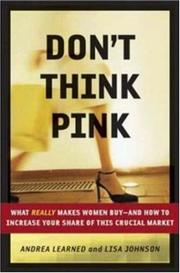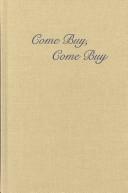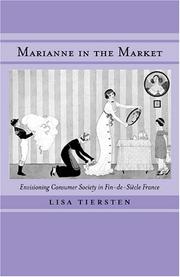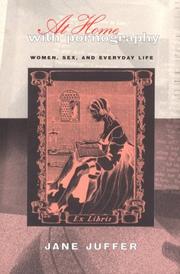| Listing 1 - 10 of 17 | << page >> |
Sort by
|
Book
ISBN: 1469604124 0807898341 9780807898345 9781469604121 9780807833278 0807833274 Year: 2010 Publisher: Chapel Hill University of North Carolina Press
Abstract | Keywords | Export | Availability | Bookmark
 Loading...
Loading...Choose an application
- Reference Manager
- EndNote
- RefWorks (Direct export to RefWorks)
Supermarkets are a mundane feature in the landscape, but as Tracey Deutsch reveals, they represent a major transformation in the ways that Americans feed themselves. In her examination of the history of food distribution in the United States, Deutsch demonstrates the important roles that gender, business, class, and the state played in the evolution of American grocery stores. Deutsch's analysis reframes shopping as labor and embeds consumption in the structures of capitalism. The supermarket, that icon of postwar American life, emerged not from straightforward consumer demand for low
Supermarkets --- Grocery trade --- Grocery shopping --- Women consumers --- History --- Social aspects
Book
ISBN: 0774824697 0774824700 9780774824705 9780774824712 0774824719 9780774824699 9780774824682 0774824689 0774819502 9780774819503 Year: 2013 Publisher: Vancouver
Abstract | Keywords | Export | Availability | Bookmark
 Loading...
Loading...Choose an application
- Reference Manager
- EndNote
- RefWorks (Direct export to RefWorks)
Positioning consumer culture in Canada within a wider international context, Consuming Modernity explores the roots of modern Western mass culture between 1919 and 1945, when the female worker, student, and homemaker relied on new products to raise their standards of living and separate themselves from oppressive traditional attitudes. Mass-produced consumer products promised to free up women to pursue other interests shaped by marketing campaigns, advertisements, films, and radio shows. Concerns over fashion, personal hygiene, body image, and health reflected these new expectations. This volume is a fascinating look at how the forces of consumerism defined and redefined a generation.
Consumption (Economics) --- Women consumers --- Women in advertising --- Sex differences --- History --- Political aspects
Book
ISBN: 019802181X 128065483X 1423737474 0195361180 1601298439 0197717888 Year: 2023 Publisher: New York ; Oxford University Press,
Abstract | Keywords | Export | Availability | Bookmark
 Loading...
Loading...Choose an application
- Reference Manager
- EndNote
- RefWorks (Direct export to RefWorks)
Shoplifting --- Female offenders --- Middle class women --- History --- Women consumers --- Department stores
Book
ISBN: 1576754723 9786612299209 1282299204 1576757838 9781576757833 9781609944285 1609944283 9781576754726 9781282299207 6612299207 Year: 2008 Publisher: San Francisco : Berrett-Koehler Publishers,
Abstract | Keywords | Export | Availability | Bookmark
 Loading...
Loading...Choose an application
- Reference Manager
- EndNote
- RefWorks (Direct export to RefWorks)
Offers social change organisations with recommendations for leveraging the untapped power of women for positive change through fundraising, advocacy and the ballot box.
Women consumers. --- Business. --- Women consumers --- Social marketing --- Women in nonprofit organizations --- Commerce --- Management --- Business & Economics --- Marketing & Sales --- Industrial Management --- Cause related marketing --- Marketing, Social --- Social cause marketing --- Nonprofit organizations --- Marketing

ISBN: 0814428002 9780814428009 9780814408155 081440815X 081440815X Year: 2004 Publisher: New York AMACOM
Abstract | Keywords | Export | Availability | Bookmark
 Loading...
Loading...Choose an application
- Reference Manager
- EndNote
- RefWorks (Direct export to RefWorks)
Women spend trillions of dollars every year. Why are you missing out?
Women consumers. --- Marketing. --- Consumer goods --- Domestic marketing --- Retail marketing --- Retail trade --- Industrial management --- Aftermarkets --- Selling --- Women as consumers --- Consumers --- Marketing
Book
ISBN: 9780674240292 0674240294 9780674240315 0674240316 9780674987272 0674987276 Year: 2019 Publisher: Cambridge, MA
Abstract | Keywords | Export | Availability | Bookmark
 Loading...
Loading...Choose an application
- Reference Manager
- EndNote
- RefWorks (Direct export to RefWorks)
Popular culture assumes that women are born to shop and that cities invite their trade. But downtowns were not always welcoming to women. Emily Remus turns to Chicago at the turn of the last century to chronicle an unheralded revolution in women's rights that took place not at the ballot box but in the streets and stores of the business district.
E-books --- Women consumers --- Shopping --- Purchasing power --- Retail trade --- History. --- Loop (Chicago, Ill.) --- Chicago (Ill.) --- Economic conditions.
Book
ISBN: 0674240316 0674240294 Year: 2019 Publisher: Cambridge, MA : Harvard University Press,
Abstract | Keywords | Export | Availability | Bookmark
 Loading...
Loading...Choose an application
- Reference Manager
- EndNote
- RefWorks (Direct export to RefWorks)
Popular culture assumes that women are born to shop and that cities invite their trade. But downtowns were not always welcoming to women. Emily Remus turns to Chicago at the turn of the last century to chronicle an unheralded revolution in women's rights that took place not at the ballot box but in the streets and stores of the business district.
Women consumers --- Shopping --- Purchasing power --- Retail trade --- History. --- History. --- History. --- History. --- Loop (Chicago, Ill.) --- Chicago (Ill.) --- History. --- Economic conditions.

ISBN: 9780821418116 0821418114 9780821418109 0821418106 0821442929 9780821442920 Year: 2008 Publisher: Athens Ohio University Press
Abstract | Keywords | Export | Availability | Bookmark
 Loading...
Loading...Choose an application
- Reference Manager
- EndNote
- RefWorks (Direct export to RefWorks)
From the 1860's through the early twentieth century, Great Britain saw the rise of the department store and the institutionalization of a gendered sphere of consumption. Come Buy, Come Buy considers representations of the female shopper in British women's writing and demonstrates how women's shopping practices are materialized as forms of narrative, poetic, and cultural inscription, showing how women writers emphasize consumerism as productive of pleasure rather than the condition of seduction or loss. Krista Lysack examines works by Christina Rossetti, Mary Elizabeth Braddon, George Eliot,
Consumption (Economics) -- Great Britain -- History -- 19th century. --- Consumption (Economics) in literature. --- English literature -- 19th century -- History and criticism. --- English literature -- Women authors -- History and criticism. --- Femininity in literature. --- Identity (Psychology) in literature. --- Shopping -- Great Britain -- History -- 19th century. --- Shopping in literature. --- Women consumers -- Great Britain -- History -- 19th century. --- Women consumers in literature. --- Consumption (Economics) in literature --- Consumption (Economics) --- English literature --- Women consumers in literature --- Shopping in literature --- Femininity in literature --- Identity (Psychology) in literature --- Women consumers --- Shopping --- English Literature --- English --- Languages & Literatures --- History and criticism --- Women authors --- History --- History and criticism. --- Consumer demand --- Consumer spending --- Consumerism --- Spending, Consumer --- Buyers' guides --- Shoppers' guides --- Women as consumers --- Femininity (Psychology) in literature --- Demand (Economic theory) --- Purchasing --- Retail trade --- Consumer education --- Personal shoppers --- Consumers --- British literature --- Inklings (Group of writers) --- Nonsense Club (Group of writers) --- Order of the Fancy (Group of writers) --- Women authors&delete&

ISBN: 0520225295 0520925653 9786612356353 1282356356 1597347353 9780520925656 9781597347358 9780520225299 9781282356351 Year: 2001 Publisher: Berkeley University of California Press
Abstract | Keywords | Export | Availability | Bookmark
 Loading...
Loading...Choose an application
- Reference Manager
- EndNote
- RefWorks (Direct export to RefWorks)
In the late nineteenth century, controversy over the social ramifications of the emerging consumer marketplace beset the industrialized nations of the West. In France, various commentators expressed concern that rampant commercialization threatened the republican ideal of civic-mindedness as well as the French reputation for good taste. The female bourgeois consumer was a particularly charged figure because she represented consumption run amok. Critics feared that the marketplace compromised her morality and aesthetic discernment, with dire repercussions for domestic life and public order. Marianne in the Market traces debates about the woman consumer to examine the complex encounter between the market and the republic in nineteenth-century France. It explores how agents of capitalism-advertisers, department store managers, fashion journalists, self-styled taste experts-addressed fears of consumerism through the forging of an aesthetics of the marketplace: a "marketplace modernism." In so doing, they constructed an image of the bourgeois woman as the solution to the problem of unrestrained, individualized, and irrational consumption. Commercial professionals used taste to civilize the market and to produce consumers who would preserve the French aesthetic patrimony. Tasteful consumption legitimized women's presence in the urban public and reconciled their roles as consumers with their domestic and civic responsibilities. A fascinating case study, Marianne in the Market builds on a wide range of sources such as the feminine press, decorating handbooks, exposition reports, advertising materials, novels, and etiquette books. Lisa Tiersten draws on these materials to make the compelling argument that market professionals used the allure of aesthetically informed consumerism to promote new models of the female consumer and the market in keeping with Republican ideals.
Women consumers --- Consumption (Economics) --- Middle class --- Aesthetics, Modern --- Consommatrices --- Consommation (Economie politique) --- Bourgeoisie --- Esthétique moderne --- History --- Histoire --- France --- Economic conditions --- Civilization --- Conditions économiques --- Civilisation --- 19th century. --- Consumption (Economics). --- Consumption (Economics) - France - History - 19th century. --- France. --- History. --- Middle class. --- Middle class - France - History - 19th century. --- Women consumers. --- Women consumers-- France-- History-- 19th century. --- Business & Economics --- Economic History --- Esthétique moderne --- Conditions économiques --- Aesthetics --- Commons (Social order) --- Middle classes --- Consumer demand --- Consumer spending --- Consumerism --- Spending, Consumer --- Women as consumers --- Social conditions --- Social classes --- Demand (Economic theory) --- Consumers --- E-books --- advertising. --- aesthetics. --- bourgeoisie. --- capitalism. --- commercialization. --- consumer culture. --- department stores. --- domesticity. --- economics. --- etiquette books. --- fashion. --- female bourgeois. --- female consumer. --- female morality. --- france. --- french culture. --- french republic. --- french women. --- gender roles. --- gender studies. --- gender. --- good taste. --- la belle epoque. --- nonfiction. --- republican. --- women. --- womens studies.

ISBN: 0585314721 9780585314723 081474236X 9780814742365 9780814742372 0814742378 0814742378 0814743994 Year: 1998 Publisher: New York, N.Y. New York University Press
Abstract | Keywords | Export | Availability | Bookmark
 Loading...
Loading...Choose an application
- Reference Manager
- EndNote
- RefWorks (Direct export to RefWorks)
Twenty-five years after the start of the feminist sex wars, pornography remains a flashpoint issue, with feminists locked in a familiar argument: Are women victims or agents? In At Home with Pornography, Jane Juffer exposes the fruitlessness of this debate and suggests that it has prevented us from realizing women's changing relationship to erotica and porn.Over the course of these same twenty-five years, there has been a proliferation of sexually explicit materials geared toward women, made available in increasingly mainstream venues. In asking "what is the relationship of women to pornography?" Juffer maintains that we need to stop obsessing over pornography's transgressive aspects, and start focusing on the place of porn and erotica in women's everyday lives. Where, she asks, do women routinely find it, for how much, and how is it circulated and consumed within the home? How is this circulation and consumption shaped by the different marketing categories that attempt to distinguish erotica from porn, such as women's literary erotica and sexual self-help videos for couples?At Home with Pornography responds to these questions by viewing women's erotica within the context of governmental regulation that attempts to counterpose a "dangerous" pornography with the sanctity of the home. Juffer explorers how women's consumption of erotica and porn for their own pleasure can be empowering, while still acting to reinforce conservative ideals. She shows how, for instance, the Victoria's Secret catalog is able to function as a kind of pornography whose circulation is facilitated both by its reliance on Victorian themes of secrecy and privacy and on its appeals to the selfish pleasures of modern career women. In her pursuit to understand what women like and how they get it, Juffer delves into adult cable channels, erotic literary anthologies, sex therapy guides, cyberporn, masturbation, and sex toys, showing the varying degrees to which these materials have been domesticated for home consumption.Representing the next generation of scholarship on pornography, At Home with Pornography will transform our understanding of women's everyday sexuality.
World history --- Sociology of the family. Sociology of sexuality --- Social policy --- Sexology --- Consumer behavior --- Mass communications --- Fiction --- History of civilization --- United States --- Pornography -- Social aspects. --- Women -- Sexual behavior. --- Women and erotica. --- Women consumers. --- Pornography --- Women and erotica --- Women --- Women consumers --- Gender & Ethnic Studies --- Social Sciences --- Gender Studies & Sexuality --- Women as consumers --- Consumers --- Human females --- Wimmin --- Woman --- Womon --- Womyn --- Females --- Human beings --- Femininity --- Erotica and women --- Erotica --- Pornography and society --- Society and pornography --- Social aspects --- Sexual Behavior --- United States of America --- Social Science --- Literature --- Fashion --- Government policy --- Attitudes --- Sexuality --- Television --- Masturbation --- Book --- Consumption --- Social science
| Listing 1 - 10 of 17 | << page >> |
Sort by
|

 Search
Search Feedback
Feedback About UniCat
About UniCat  Help
Help News
News